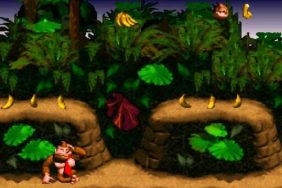There’s something immeasurably important about the first level of an old-school action platformer, and it’s a thing that any clued-in developer knows it must get right. Most gamers would attest to this, too; primarily because most gamers, whether they know it or not, do have a favorite NES or SNES first stage. A stellar leading level can make or break the player’s overall interest in a game within seconds, and be it Yoshi’s Island from Super Mario World, Jungle Hijinx from Donkey Kong Country, or any headmost challenge from the glory days of Mega Man, the best platformers bait your attention with such commanding authority that you’re left with no choice but to bob your head to the synthesized beats and get down to world-saving. The developers of Shovel Knight understand this, and composer Jake Kaufman’s “Strike the Earth!” pairs so heroically with the brisk woodland setting of the game’s initial stage that I felt compelled to fly to Valencia and high-five the folks at Yacht Club Games myself. Gaming world, I suggest you take notes.
Of course, it’s no coincidence that Shovel Knight puts its priorities in the right place; its former-WayForward creators have (presumed) experience working on some of the better tributes to classic gaming in existence, including the underrated Shantae series and the studios’ recent love letter to the original Ducktales (it’s tough to say when planning for that game began, but the point stands). With Shovel Knight, Yacht Club is dealing with entirely new IP, Kickstarter funding, and a boatload of ideas about how to best brush up mechanics and style that, in some cases, are 25 or even 30 years old. I’ve replayed NES games, and they don’t all hold up. Shovel Knight channels the ones that do, applies its own creative layer, and delivers them in a tight and well-styled package. An early level suggests the player “steel thy shovel,” and thanks to Shovel Knight’s superb pacing and learning curve, it’s probably the only advice you’re going to need.
Gameplay itself mainly involves slinging Shovel Knight’s souped-up gardening tool at foes, and even late in the game there are few enemies who can’t be defeated by a well-placed spade-shot to the cranium. The fun of progressing through the levels is due in part to the collection of relics; ancient pieces of treasure that can be bought or gathered over the course of the adventure to enhance the player’s abilities. Early on you’ll mainly use what’s made available, like a rod that shoots fireballs, but as time passed I found myself developing somewhat of my own style. One side-stage requires the use of an amulet that grants temporary invincibility, and even once I’d moved on I began utilizing it in clever ways to solve puzzles or clear areas that didn’t require it. The same idea rings true for other gathered relics, and given that some must be bought from the traveling merchant Chester, it’s perfectly feasible that you won’t collect or use them all during your initial playthrough. There’s a “new game plus” that unlocks upon completion, and thus far I’ve been able to switch my play style considerably.
Variability aside, you’ll find that your trusty trowel remains the tool of choice 50% of the time, and its flexibility lends itself nicely to the game’s sizable span of enemies. While I do wish that interesting foes would show themselves more often (many are, admittedly, Kirby-like in their ease of defeat), mini-bosses show up occasionally to temper your pace, and more importantly, reward you with treasure upon their demise. One encounter has Shovel Knight facing off against a bearded scientist who hurls vials and jars of potions, consulting his shelf of supplies periodically for more ammo. This is when you’ll want to swipe furiously with your shovel, or better yet, use its downward spike function to repeatedly pogo the enemy’s head Ducktales style.
Traversal and dispatch of standard enemies is fun, but that’s expected — where Shovel Knight really breaches what you’d find in an actual 25-year-old NES game is with its boss design. The game’s eight enemy knights are clearly Mega Man inspired, but the attention to detail with how they behave and, more noticeably, how well they’re animated is really quite the pleasure to behold. I was wiped out by Specter Knight multiple times simply because I couldn’t stop admiring how fluidly and effortlessly he (or she?) moved while hurling a massive scepter toward my face. Elsewhere, Plague Knight hops around the stage spastically while attacking and tossing projectile vials, while King Knight opts for a more direct assault, stopping periodically so his regal trumpeters can celebrate his name.
You may be wondering why our beshoveled protagonist has enemies after him, and I’ve avoided mentioning story until now because its purpose, in this case, is secondary when it comes to assessing the game’s quality — Shovel Knight could be entirely devoid of plot and I’d likely award it the same score. That said, the fact that it delivers something compelling makes it all the more attractive, and as you slowly defeat the minions of an evil Enchantress in an effort to save your lost companion Shield Knight, odds are you’ll begin to appreciate the presence of plot more that you initially thought you would. There are occasional sequences where Shovel Knight, trapped in a nightmare, must run to save a falling Shield Knight as he staves off endless hordes of enemies, and the innocence of it all — a warrior fighting to save a lost friend — proves surprisingly affecting. This isn’t something I felt or noticed in previous WayForward efforts (and to be fair, I haven’t played them all), so to have Yacht Club employing such simple-yet-effective dramatic devices is a fine treat indeed.

There’s more to say about Shovel Knight — the bustling towns filled with engaging NPCs or the clever way in which cash is recovered upon death come to mind — but these are quirks you’ll discover for yourself when you pick it up and play. I had the pleasure of enjoying the 3DS version (the stereoscopic 3D is totally worthwhile), but my brother played on Wii U and both versions look equally sharp, colorful, and vibrant. Ultimately it comes down to whether you can appreciate a new take on a classic visual style, and if the answer is yes, you’re going to be very pleased.
There are probably kids out there who’ve considered loading Mega Man or old-school Mario onto their Virtual Consoles, but find the dated presentation too alienating or antiquated to actually spend money on. Shovel Knight reminds us that 8-bit isn’t just a hardware limitation, but a style, and in the process of delivering a 10-hour cut of top-notch classic gaming, it may very well open up the NES floodgates for a whole new generation. And if it doesn’t, that’s fine too; I’m more than content spade-spiking pixelated dragons all by my lonesome. That is, as long as there’s going to be a sequel.

Griffin Vacheron is a Writer for CraveOnline. You can follow him on Twitter @novacav.
A copy wasn’t provided by the publisher. Shovel Knight is available on 3DS, PC, and Wii U.








